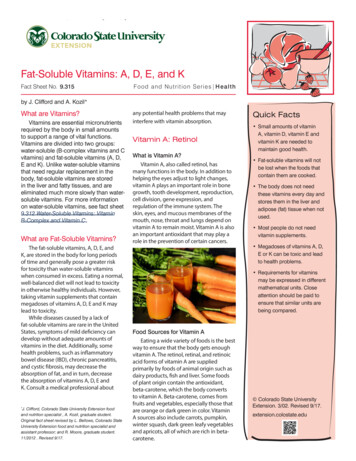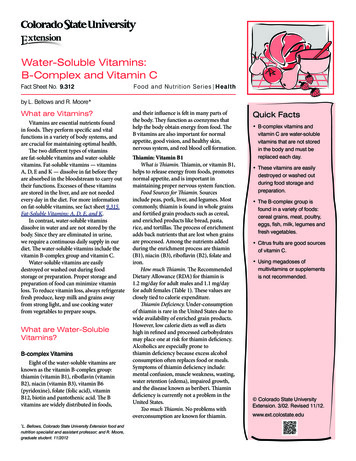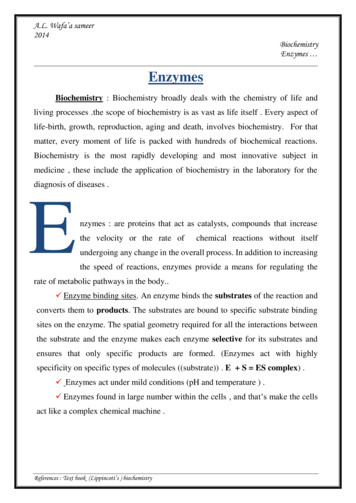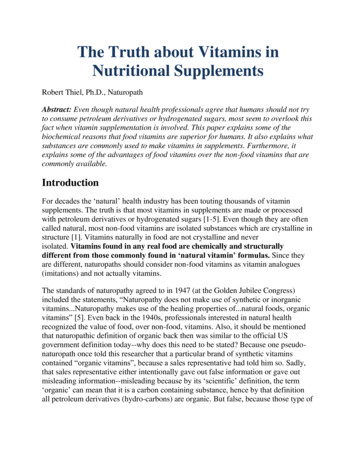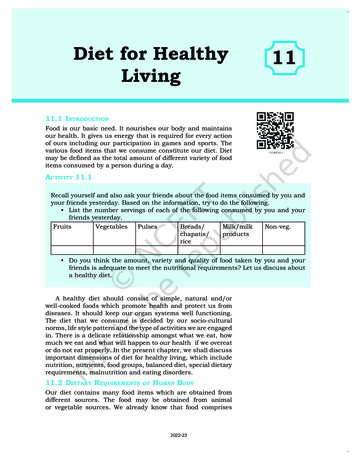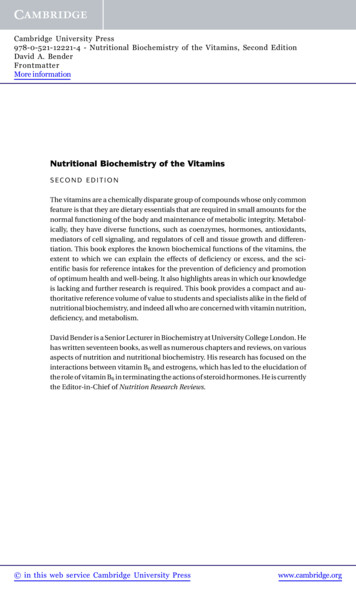
Transcription
Cambridge University Press978-0-521-12221-4 - Nutritional Biochemistry of the Vitamins, Second EditionDavid A. BenderFrontmatterMore informationNutritional Biochemistry of the VitaminsSECOND EDITIONThe vitamins are a chemically disparate group of compounds whose only commonfeature is that they are dietary essentials that are required in small amounts for thenormal functioning of the body and maintenance of metabolic integrity. Metabolically, they have diverse functions, such as coenzymes, hormones, antioxidants,mediators of cell signaling, and regulators of cell and tissue growth and differentiation. This book explores the known biochemical functions of the vitamins, theextent to which we can explain the effects of deficiency or excess, and the scientific basis for reference intakes for the prevention of deficiency and promotionof optimum health and well-being. It also highlights areas in which our knowledgeis lacking and further research is required. This book provides a compact and authoritative reference volume of value to students and specialists alike in the field ofnutritional biochemistry, and indeed all who are concerned with vitamin nutrition,deficiency, and metabolism.David Bender is a Senior Lecturer in Biochemistry at University College London. Hehas written seventeen books, as well as numerous chapters and reviews, on variousaspects of nutrition and nutritional biochemistry. His research has focused on theinteractions between vitamin B6 and estrogens, which has led to the elucidation ofthe role of vitamin B6 in terminating the actions of steroid hormones. He is currentlythe Editor-in-Chief of Nutrition Research Reviews. in this web service Cambridge University Presswww.cambridge.org
Cambridge University Press978-0-521-12221-4 - Nutritional Biochemistry of the Vitamins, Second EditionDavid A. BenderFrontmatterMore informationNutritional Biochemistryof the VitaminsSECOND EDITIONDAVID A. BENDERUniversity College London in this web service Cambridge University Presswww.cambridge.org
Cambridge University Press978-0-521-12221-4 - Nutritional Biochemistry of the Vitamins, Second EditionDavid A. BenderFrontmatterMore informationCAMBRIDGE UNIVERSITY PRESSCambridge, New York, Melbourne, Madrid, Cape Town, Singapore,São Paulo, Delhi, Dubai, TokyoCambridge University PressThe Edinburgh Building, Cambridge CB2 8RU, UKPublished in the United States of America by Cambridge University Press, New Yorkwww.cambridge.orgInformation on this title: www.cambridge.org/9780521122214 David A. Bender 2003This publication is in copyright. Subject to statutory exceptionand to the provisions of relevant collective licensing agreements,no reproduction of any part may take place without the writtenpermission of Cambridge University Press.First published 2003This digitally printed version 2009A catalogue record for this publication is available from the British LibraryISBN 978-0-521-80388-5 HardbackISBN 978-0-521-12221-4 PaperbackCambridge University Press has no responsibility for the persistence oraccuracy of URLs for external or third-party internet websites referred to inthis publication, and does not guarantee that any content on such websites is,or will remain, accurate or appropriate. in this web service Cambridge University Presswww.cambridge.org
Cambridge University Press978-0-521-12221-4 - Nutritional Biochemistry of the Vitamins, Second EditionDavid A. BenderFrontmatterMore informationContentsList of FiguresList of TablesPreface1 The Vitamins1.1 Definition and Nomenclature of the Vitamins1.1.1 Methods of Analysis and Units of Activity1.1.2 Biological Availability1.2 Vitamin Requirements and Reference Intakes1.2.1 Criteria of Vitamin Adequacy and the Stages ofDevelopment of Deficiency1.2.2 Assessment of Vitamin Nutritional Status1.2.3 Determination of Requirements1.2.3.1 Population Studies of Intake1.2.3.2 Depletion/Repletion Studies1.2.3.3 Replacement of Metabolic Losses1.2.3.4 Studies in Patients Maintained on TotalParenteral Nutrition1.2.4 Reference Intakes of Vitamins1.2.4.1 Adequate Intake1.2.4.2 Reference Intakes for Infants and Children1.2.4.3 Tolerable Upper Levels of Intake1.2.4.4 Reference Intake Figures for Food Labeling2 Vitamin A: Retinoids and Carotenoids2.1 Vitamin A Vitamers and Units of Activity2.1.1 Retinoids2.1.2 Carotenoids2.1.3 International Units and Retinol Equivalentspage 35v in this web service Cambridge University Presswww.cambridge.org
Cambridge University Press978-0-521-12221-4 - Nutritional Biochemistry of the Vitamins, Second EditionDavid A. BenderFrontmatterMore informationContentsvi2.2 Absorption and Metabolism of Vitamin A and Carotenoids2.2.1 Absorption and Metabolism of Retinol and Retinoic Acid2.2.1.1 Liver Storage and Release of Retinol2.2.1.2 Metabolism of Retinoic Acid2.2.1.3 Retinoyl Glucuronide and Other Metabolites2.2.2 Absorption and Metabolism of Carotenoids2.2.2.1 Carotene Dioxygenase2.2.2.2 Limited Activity of Carotene Dioxygenase2.2.2.3 The Reaction Specificity of Carotene Dioxygenase2.2.3 Plasma Retinol Binding Protein (RBP)2.2.4 Cellular Retinoid Binding Proteins CRBPs andCRABPs2.3 Metabolic Functions of Vitamin A2.3.1 Retinol and Retinaldehyde in the Visual Cycle2.3.2 Genomic Actions of Retinoic Acid2.3.2.1 Retinoid Receptors and Response Elements2.3.3 Nongenomic Actions of Retinoids2.3.3.1 Retinoylation of Proteins2.3.3.2 Retinoids in Transmembrane Signaling2.4 Vitamin A Deficiency (Xerophthalmia)2.4.1 Assessment of Vitamin A Nutritional Status2.4.1.1 Plasma Concentrations of Retinol and β-Carotene2.4.1.2 Plasma Retinol Binding Protein2.4.1.3 The Relative Dose Response (RDR) Test2.4.1.4 Conjunctival Impression Cytology2.5 Vitamin A Requirements and Reference Intakes2.5.1 Toxicity of Vitamin A2.5.1.1 Teratogenicity of Retinoids2.5.2 Pharmacological Uses of Vitamin A, Retinoids,and Carotenoids2.5.2.1 Retinoids in Cancer Prevention and Treatment2.5.2.2 Retinoids in Dermatology2.5.2.3 Carotene3 Vitamin D3.1 Vitamin D Vitamers, Nomenclature, and Units of Activity3.2 Metabolism of Vitamin D3.2.1 Photosynthesis of Cholecalciferol in the Skin3.2.2 Dietary Vitamin D3.2.3 25-Hydroxylation of Cholecalciferol3.2.4 Calcidiol 1α-Hydroxylase3.2.5 Calcidiol 24-Hydroxylase3.2.6 Inactivation and Excretion of Calcitriol3.2.7 Plasma Vitamin D Binding Protein (Gc-Globulin) in this web service Cambridge University .org
Cambridge University Press978-0-521-12221-4 - Nutritional Biochemistry of the Vitamins, Second EditionDavid A. BenderFrontmatterMore informationContents3.2.8 Regulation of Vitamin D Metabolism3.2.8.1 Calcitriol3.2.8.2 Parathyroid Hormone3.2.8.3 Calcitonin3.2.8.4 Plasma Concentrations of Calcium and Phosphate3.3 Metabolic Functions of Vitamin D3.3.1 Nuclear Vitamin D Receptors3.3.2 Nongenomic Responses to Vitamin D3.3.3 Stimulation of Intestinal Calcium and Phosphate Absorption3.3.3.1 Induction of Calbindin-D3.3.4 Stimulation of Renal Calcium Reabsorption3.3.5 The Role of Calcitriol in Bone Metabolism3.3.6 Cell Differentiation, Proliferation, and Apoptosis3.3.7 Other Functions of Calcitriol3.3.7.1 Endocrine Glands3.3.7.2 The Immune System3.4 Vitamin D Deficiency – Rickets and Osteomalacia3.4.1 Nonnutritional Rickets and Osteomalacia3.4.2 Vitamin D-Resistant Rickets3.4.3 Osteoporosis3.4.3.1 Glucocorticoid-Induced Osteoporosis3.5 Assessment of Vitamin D Status3.6 Requirements and Reference Intakes3.6.1 Toxicity of Vitamin D3.6.2 Pharmacological Uses of Vitamin D4 Vitamin E: Tocopherols and Tocotrienols4.1 Vitamin E Vitamers and Units of Activity4.2 Metabolism of Vitamin E4.3 Metabolic Functions of Vitamin E4.3.1 Antioxidant Functions of Vitamin E4.3.1.1 Prooxidant Actions of Vitamin E4.3.1.2 Reaction of Tocopherol with Peroxynitrite4.3.2 Nutritional Interactions Between Selenium and Vitamin E4.3.3 Functions of Vitamin E in Cell Signaling4.4 Vitamin E Deficiency4.4.1 Vitamin E Deficiency in Experimental Animals4.4.2 Human Vitamin E Deficiency4.5 Assessment of Vitamin E Nutritional Status4.6 Requirements and Reference Intakes4.6.1 Upper Levels of Intake4.6.2 Pharmacological Uses of Vitamin E4.6.2.1 Vitamin E and Cancer4.6.2.2 Vitamin E and Cardiovascular Disease in this web service Cambridge University 5125127128128129129www.cambridge.org
Cambridge University Press978-0-521-12221-4 - Nutritional Biochemistry of the Vitamins, Second EditionDavid A. BenderFrontmatterMore informationContentsviii4.6.2.3 Vitamin E and Cataracts4.6.2.4 Vitamin E and Neurodegenerative Diseases5 Vitamin K5.1 Vitamin K Vitamers5.2 Metabolism of Vitamin K5.2.1 Bacterial Biosynthesis of Menaquinones5.3 The Metabolic Functions of Vitamin K5.3.1 The Vitamin K-Dependent Carboxylase5.3.2 Vitamin K-Dependent Proteins in Blood Clotting5.3.3 Osteocalcin and Matrix Gla Protein5.3.4 Vitamin K-Dependent Proteins in Cell Signaling – Gas65.4 Vitamin K Deficiency5.4.1 Vitamin K Deficiency Bleeding in Infancy5.5 Assessment of Vitamin K Nutritional Status5.6 Vitamin K Requirements and Reference Intakes5.6.1 Upper Levels of Intake5.6.2 Pharmacological Uses of Vitamin K6 Vitamin B1 – Thiamin6.1 Thiamin Vitamers and Antagonists6.2 Metabolism of Thiamin6.2.1 Biosynthesis of Thiamin6.3 Metabolic Functions of Thiamin6.3.1 Thiamin Diphosphate in the Oxidative Decarboxylationof Oxoacids6.3.1.1 Regulation of Pyruvate Dehydrogenase Activity6.3.1.2 Thiamin-Responsive Pyruvate DehydrogenaseDeficiency6.3.1.3 2-Oxoglutarate Dehydrogenase and the γ -AminobutyricAcid (GABA) Shunt6.3.1.4 Branched-Chain Oxo-acid Decarboxylase and MapleSyrup Urine Disease6.3.2 Transketolase6.3.3 The Neuronal Function of Thiamin Triphosphate6.4 Thiamin Deficiency6.4.1 Dry Beriberi6.4.2 Wet Beriberi6.4.3 Acute Pernicious (Fulminating) Beriberi – Shoshin Beriberi6.4.4 The Wernicke–Korsakoff Syndrome6.4.5 Effects of Thiamin Deficiency on Carbohydrate Metabolism6.4.6 Effects of Thiamin Deficiency on Neurotransmitters6.4.6.1 Acetylcholine6.4.6.2 5-Hydroxytryptamine6.4.7 Thiaminases and Thiamin Antagonists in this web service Cambridge University 2162163164165165165166www.cambridge.org
Cambridge University Press978-0-521-12221-4 - Nutritional Biochemistry of the Vitamins, Second EditionDavid A. BenderFrontmatterMore informationContents6.5 Assessment of Thiamin Nutritional Status6.5.1 Urinary Excretion of Thiamin and Thiochrome6.5.2 Blood Concentration of Thiamin6.5.3 Erythrocyte Transketolase Activation6.6 Thiamin Requirements and Reference Intakes6.6.1 Upper Levels of Thiamin Intake6.6.2 Pharmacological Uses of Thiamin7 Vitamin B2 – Riboflavin7.1 Riboflavin and the Flavin Coenzymes7.2 The Metabolism of Riboflavin7.2.1 Absorption, Tissue Uptake, and Coenzyme Synthesis7.2.2 Riboflavin Binding Protein7.2.3 Riboflavin Homeostasis7.2.4 The Effect of Thyroid Hormones on Riboflavin Metabolism7.2.5 Catabolism and Excretion of Riboflavin7.2.6 Biosynthesis of Riboflavin7.3 Metabolic Functions of Riboflavin7.3.1 The Flavin Coenzymes: FAD and Riboflavin Phosphate7.3.2 Single-Electron-Transferring Flavoproteins7.3.3 Two-Electron-Transferring Flavoprotein Dehydrogenases7.3.4 Nicotinamide Nucleotide Disulfide Oxidoreductases7.3.5 Flavin Oxidases7.3.6 NADPH Oxidase, the Respiratory Burst Oxidase7.3.7 Molybdenum-Containing Flavoprotein Hydroxylases7.3.8 Flavin Mixed-Function Oxidases (Hydroxylases)7.3.9 The Role of Riboflavin in the Cryptochromes7.4 Riboflavin Deficiency7.4.1 Impairment of Lipid Metabolism in Riboflavin Deficiency7.4.2 Resistance to Malaria in Riboflavin Deficiency7.4.3 Secondary Nutrient Deficiencies in Riboflavin Deficiency7.4.4 Iatrogenic Riboflavin Deficiency7.5 Assessment of Riboflavin Nutritional Status7.5.1 Urinary Excretion of Riboflavin7.5.2 Erythrocyte Glutathione Reductase (EGR) ActivationCoefficient7.6 Riboflavin Requirements and Reference Intakes7.7 Pharmacological Uses of Riboflavin8 Niacin8.1 Niacin Vitamers and Nomenclature8.2 Niacin Metabolism8.2.1 Digestion and Absorption8.2.1.1 Unavailable Niacin in Cereals8.2.2 Synthesis of the Nicotinamide Nucleotide Coenzymes in this web service Cambridge University 196196197197198200201203203203203www.cambridge.org
Cambridge University Press978-0-521-12221-4 - Nutritional Biochemistry of the Vitamins, Second EditionDavid A. BenderFrontmatterMore informationContentsx8.2.3 Catabolism of NAD(P)8.2.4 Urinary Excretion of Niacin Metabolites8.3 The Synthesis of Nicotinamide Nucleotides from Tryptophan8.3.1 Picolinate Carboxylase and Nonenzymic Cyclization toQuinolinic Acid8.3.2 Tryptophan Dioxygenase8.3.2.1 Saturation of Tryptophan Dioxygenase with ItsHeme Cofactor8.3.2.2 Induction of Tryptophan Dioxygenase byGlucocorticoid Hormones8.3.2.3 Induction Tryptophan Dioxygenase by Glucagon8.3.2.4 Repression and Inhibition of Tryptophan Dioxygenaseby Nicotinamide Nucleotides8.3.3 Kynurenine Hydroxylase and Kynureninase8.3.3.1 Kynurenine Hydroxylase8.3.3.2 Kynureninase8.4 Metabolic Functions of Niacin8.4.1 The Redox Function of NAD(P)8.4.1.1 Use of NAD(P) in Enzyme Assays8.4.2 ADP-Ribosyltransferases8.4.3 Poly(ADP-ribose) Polymerases8.4.4 cADP-Ribose and Nicotinic Acid Adenine DinucleotidePhosphate (NAADP)8.5 Pellagra – A Disease of Tryptophan and Niacin Deficiency8.5.1 Other Nutrient Deficiencies in the Etiology of Pellagra8.5.2 Possible Pellagragenic Toxins8.5.3 The Pellagragenic Effect of Excess Dietary Leucine8.5.4 Inborn Errors of Tryptophan Metabolism8.5.5 Carcinoid Syndrome8.5.6 Drug-Induced Pellagra8.6 Assessment of Niacin Nutritional Status8.6.1 Tissue and Whole Blood Concentrations of NicotinamideNucleotides8.6.2 Urinary Excretion of N 1 -Methyl Nicotinamide and MethylPyridone Carboxamide8.7 Niacin Requirements and Reference Intakes8.7.1 Upper Levels of Niacin Intake8.8 Pharmacological Uses of Niacin9 Vitamin B69.1 Vitamin B6 Vitamers and Nomenclature9.2 Metabolism of Vitamin B69.2.1 Muscle Pyridoxal Phosphate9.2.2 Biosynthesis of Vitamin B69.3 Metabolic Functions of Vitamin B69.3.1 Pyridoxal Phosphate in Amino Acid Metabolism9.3.1.1 α-Decarboxylation of Amino Acids in this web service Cambridge University 2233234236236236237239www.cambridge.org
Cambridge University Press978-0-521-12221-4 - Nutritional Biochemistry of the Vitamins, Second EditionDavid A. BenderFrontmatterMore informationContents9.3.1.2 Racemization of the Amino Acid Substrate9.3.1.3 Transamination of Amino Acids (AminotransferaseReactions)9.3.1.4 Steps in the Transaminase Reaction9.3.1.5 Transamination Reactions of Other PyridoxalPhosphate Enzymes9.3.1.6 Transamination and Oxidative Deamination Catalyzedby Dihydroxyphenylalanine (DOPA) Decarboxylase9.3.1.7 Side-Chain Elimination and Replacement Reactions9.3.2 The Role of Pyridoxal Phosphate in Glycogen Phosphorylase9.3.3 The Role of Pyridoxal Phosphate in Steroid Hormone Actionand Gene Expression9.4 Vitamin B6 Deficiency9.4.1 Enzyme Responses to Vitamin B6 Deficiency9.4.2 Drug-Induced Vitamin B6 Deficiency9.4.3 Vitamin B6 Dependency Syndromes9.5 The Assessment of Vitamin B6 Nutritional Status9.5.1 Plasma Concentrations of Vitamin B69.5.2 Urinary Excretion of Vitamin B6 and 4-Pyridoxic Acid9.5.3 Coenzyme Saturation of Transaminases9.5.4 The Tryptophan Load Test9.5.4.1 Artifacts in the Tryptophan Load Test Associated withIncreased Tryptophan Dioxygenase Activity9.5.4.2 Estrogens and Apparent Vitamin B6 Nutritional Status9.5.5 The Methionine Load Test9.6 Vitamin B6 Requirements and Reference Intakes9.6.1 Vitamin B6 Requirements Estimated from MetabolicTurnover9.6.2 Vitamin B6 Requirements Estimated from Depletion/Repletion Studies9.6.3 Vitamin B6 Requirements of Infants9.6.4 Toxicity of Vitamin B69.6.4.1 Upper Levels of Vitamin B6 Intake9.7 Pharmacological Uses of Vitamin B69.7.1 Vitamin B6 and Hyperhomocysteinemia9.7.2 Vitamin B6 and the Premenstrual Syndrome9.7.3 Impaired Glucose Tolerance9.7.4 Vitamin B6 for Prevention of the Complications ofDiabetes Mellitus9.7.5 Vitamin B6 for the Treatment of Depression9.7.6 Antihypertensive Actions of Vitamin B69.8 Other Carbonyl Catalysts9.8.1 Pyruvoyl Enzymes9.8.2 Pyrroloquinoline Quinone (PQQ) and TryptophanTryptophylquinone (TTQ)9.8.3 Quinone Catalysts in Mammalian Enzymes in this web service Cambridge University 264264265266266268www.cambridge.org
Cambridge University Press978-0-521-12221-4 - Nutritional Biochemistry of the Vitamins, Second EditionDavid A. BenderFrontmatterMore informationContentsxii10 Folate and Other Pterins and Vitamin B1210.1 Folate Vitamers and Dietary Folate Equivalents10.1.1 Dietary Folate Equivalents10.2 Metabolism of Folates10.2.1 Digestion and Absorption of Folates10.2.2 Tissue Uptake and Metabolism of Folate10.2.2.1 Poly-γ -glutamylation of Folate10.2.3 Catabolism and Excretion of Folate10.2.4 Biosynthesis of Pterins10.3 Metabolic Functions of Folate10.3.1 Sources of Substituted Folates10.3.1.1 Serine Hydroxymethyltransferase10.3.1.2 Histidine Catabolism10.3.1.3 Other Sources of One-Carbon Substituted Folates10.3.2 Interconversion of Substituted Folates10.3.2.1 Methylene-Tetrahydrofolate Reductase10.3.2.2 Disposal of Surplus One-Carbon Fragments10.3.3 Utilization of One-Carbon Substituted Folates10.3.3.1 Thymidylate Synthetase and Dihydrofolate Reductase10.3.3.2 Dihydrofolate Reductase Inhibitors10.3.3.3 The dUMP Suppression Test10.3.4 The Role of Folate in Methionine Metabolism10.3.4.1 The Methyl Folate Trap Hypothesis10.3.4.2 Hyperhomocysteinemia and Cardiovascular Disease10.4 Tetrahydrobiopterin10.4.1 The Role of Tetrahydrobiopterin in Aromatic AminoAcid Hydroxylases10.4.2 The Role of Tetrahydrobiopterin in Nitric Oxide Synthase10.5 Molybdopterin10.6 Vitamin B12 Vitamers and Nomenclature10.7 Metabolism of Vitamin B1210.7.1 Digestion and Absorption of Vitamin B1210.7.2 Plasma Vitamin B12 Binding Proteins and Tissue Uptake10.7.3 Bacterial Biosynthesis of Vitamin B1210.8 Metabolic Functions of Vitamin B1210.8.1 Methionine Synthetase10.8.2 Methylmalonyl CoA Mutase10.8.3 Leucine Aminomutase10.9 Deficiency of Folic Acid and Vitamin B1210.9.1 Megaloblastic Anemia10.9.2 Pernicious Anemia10.9.3 Neurological Degeneration in Vitamin B12 Deficiency10.9.4 Folate Deficiency and Neural Tube Defects10.9.5 Folate Deficiency and Cancer Risk10.9.6 Drug-Induced Folate Deficiency10.9.7 Drug-Induced Vitamin B12 Deficiency in this web service Cambridge University dge.org
Cambridge University Press978-0-521-12221-4 - Nutritional Biochemistry of the Vitamins, Second EditionDavid A. BenderFrontmatterMore informationContents10.10 Assessment of Folate and Vitamin B12 Nutritional Status10.10.1 Plasma and Erythrocyte Concentrations of Folateand Vitamin B1210.10.2 The Schilling Test for Vitamin B12 Absorption10.10.3 Methylmalonic Aciduria and Methylmalonic Acidemia10.10.4 Histidine Metabolism – the FIGLU Test10.10.5 The dUMP Suppression Test10.11 Folate and Vitamin B12 Requirements and ReferenceIntakes10.11.1 Folate Requirements10.11.2 Vitamin B12 Requirements10.11.3 Upper Levels of Folate Intake10.12 Pharmacological Uses of Folate and Vitamin B1211 Biotin (Vitamin H)11.1 Metabolism of Biotin11.1.1 Bacterial Synthesis of Biotin11.1.1.1 The Importance of Intestinal Bacterial Synthesisof Biotin11.2 The Metabolic Functions of Biotin11.2.1 The Role of Biotin in Carboxylation Reactions11.2.1.1 Acetyl CoA Carboxylase11.2.1.2 Pyruvate Carboxylase11.2.1.3 Propionyl CoA Carboxylase11.2.1.4 Methylcrotonyl CoA Carboxylase11.2.2 Holocarboxylase Synthetase11.2.2.1 Holocarboxylase Synthetase Deficiency11.2.3 Biotinidase11.2.3.1 Biotinidase Deficiency11.2.4 Enzyme Induction by Biotin11.2.5 Biotin in Regulation of the Cell Cycle11.3 Biotin Deficiency11.3.1 Metabolic Consequences of Biotin Deficiency11.3.1.1 Glucose Homeostasis in Biotin Deficiency11.3.1.2 Fatty Liver and Kidney Syndrome in Biotin-DeficientChicks11.3.1.3 Cot Death11.3.2 Biotin Deficiency In Pregnancy11.4 Assessment of Biotin Nutritional Status11.5 Biotin Requirements11.6 Avidin12 Pantothenic Acid12.1 Pantothenic Acid Vitamers12.2 Metabolism of Pantothenic Acid12.2.1 The Formation of CoA from Pantothenic Acid12.2.1.1 Metabolic Control of CoA Synthesis in this web service Cambridge University 38339340340341341345345346348349www.cambridge.org
Cambridge University Press978-0-521-12221-4 - Nutritional Biochemistry of the Vitamins, Second EditionDavid A. BenderFrontmatterMore informationContentsxiv12.2.2 Catabolism of CoA12.2.3 The Formation and Turnover of ACP12.2.4 Biosynthesis of Pantothenic Acid12.3 Metabolic Functions of Pantothenic Acid12.4 Pantothenic Acid Deficiency12.4.1 Pantothenic Acid Deficiency in Experimental Animals12.4.2 Human Pantothenic Acid Deficiency – The BurningFoot Syndrome12.5 Assessment of Pantothenic Acid Nutritional Status12.6 Pantothenic Acid Requirements12.7 Pharmacological Uses of Pantothenic Acid13 Vitamin C (Ascorbic Acid)13.1 Vitamin C Vitamers and Nomenclature13.1.1 Assay of Vitamin C13.2 Metabolism of Vitamin C13.2.1 Intestinal Absorption and Secretion of Vitamin C13.2.2 Tissue Uptake of Vitamin C13.2.3 Oxidation and Reduction of Ascorbate13.2.4 Metabolism and Excretion of Ascorbate13.3 Metabolic Functions of Vitamin C13.3.1 Dopamine β-Hydroxylase13.3.2 Peptidyl Glycine Hydroxylase (Peptide α-Amidase)13.3.3 2-Oxoglutarate–Linked Iron-Containing Hydroxylases13.3.4 Stimulation of Enzyme Activity by Ascorbate In Vitro13.3.5 The Role of Ascorbate in Iron Absorption andMetabolism13.3.6 Inhibition of Nitrosamine Formation by Ascorbate13.3.7 Pro- and Antioxidant Roles of Ascorbate13.3.7.1 Reduction of the Vitamin E Radical by Ascorbate13.3.8 Ascorbic Acid in Xenobiotic and Cholesterol Metabolism13.4 Vitamin C Deficiency – Scurvy13.4.1 Anemia in Scurvy13.5 Assessment of Vitamin C Status13.5.1 Urinary Excretion of Vitamin C and Saturation Testing13.5.2 Plasma and Leukocyte Concentrations of Ascorbate13.5.3 Markers of DNA Oxidative Damage13.6 Vitamin C Requirements and Reference Intakes13.6.1 The Minimum Requirement for Vitamin C13.6.2 Requirements Estimated from the Plasma and LeukocyteConcentrations of Ascorbate13.6.3 Requirements Estimated from Maintenance of the BodyPool of Ascorbate13.6.4 Higher Recommendations13.6.4.1 The Effect of Smoking on Vitamin C Requirements in this web service Cambridge University 4374376376376378378379380www.cambridge.org
Cambridge University Press978-0-521-12221-4 - Nutritional Biochemistry of the Vitamins, Second EditionDavid A. BenderFrontmatterMore informationContents13.6.5 Safety and Upper Levels of Intake of Vitamin C13.6.5.1 Renal Stones13.6.5.2 False Results in Urine Glucose Testing13.6.5.3 Rebound Scurvy13.6.5.4 Ascorbate and Iron Overload13.7 Pharmacological Uses of Vitamin C13.7.1 Vitamin C in Cancer Prevention and Therapy13.7.2 Vitamin C in Cardiovascular Disease13.7.3 Vitamin C and the Common Cold14 Marginal Compounds and Phytonutrients14.1 Carnitine14.1.1 Biosynthesis and Metabolism of Carnitine14.1.2 The Possible Essentiality of Carnitine14.1.3 Carnitine as an Ergogenic Aid14.2 Choline14.2.1 Biosynthesis and Metabolism of Choline14.2.2 The Possible Essentiality of Choline14.3 Creatine14.4 Inositol14.4.1 Phosphatidylinositol in Transmembrane Signaling14.4.2 The Possible Essentiality of Inositol14.5 Taurine14.5.1 Biosynthesis of Taurine14.5.2 Metabolic Functions of Taurine14.5.2.1 Taurine Conjugation of Bile Acids14.5.2.2 Taurine in the Central Nervous System14.5.2.3 Taurine and Heart Muscle14.5.3 The Possible Essentiality of Taurine14.6 Ubiquinone (Coenzyme Q)14.7 Phytonutrients: Potentially Protective Compounds inPlant Foods14.7.1 Allyl Sulfur Compounds14.7.2 Flavonoids and Polyphenols14.7.3 Glucosinolates14.7.4 400401401402403404Bibliography409Index463 in this web service Cambridge University Presswww.cambridge.org
Cambridge University Press978-0-521-12221-4 - Nutritional Biochemistry of the Vitamins, Second EditionDavid A. BenderFrontmatterMore informationList of Figures1.1. Derivation of reference intakes of nutrients.1.2. Derivation of requirements or reference intakes for children.1.3. Derivation of reference intake (RDA) and tolerable upper level (UL)for a nutrient.2.1.2.2.2.3.2.4.2.5.2.6.2.7.2.8.Major physiologically active retinoids.Major dietary carotenoids.Oxidative cleavage of β-carotene by carotene dioxygenase.Potential products arising from enzymic or nonenzymicsymmetrical or asymmetric oxidative cleavage of β-carotene.Role of retinol in the visual cycle.Interactions of all-trans- and 9-cis-retinoic acids (and other activeretinoids) with retinoid receptors.Retinoylation of proteins by retinoyl CoA.Retinoylation of proteins by 4-hydroxyretinoic acid.3.1. Vitamin D vitamers.3.2. Synthesis of calciol from 7-dehydrocholesterol in the skin.3.3. Metabolism of calciol to yield calcitriol and n E vitamers.Stereochemistry of α-tocopherol.Reaction of tocopherol with lipid peroxides.Resonance forms of the vitamin E radicals.Role of vitamin E as a chain-perpetuating prooxidant.Reactions of α- and γ -tocopherol with 41171181195.1. Vitamin K vitamers.5.2. Reaction of the vitamin K-dependent carboxylase.5.3. Intrinsic and extrinsic blood clotting cascades.1321371406.1. Thiamin and thiamin analogs.6.2. Reaction of the pyruvate dehydrogenase complex.6.3. GABA shunt as an alternative to α-ketoglutarate dehydrogenase inthe citric acid cycle.149154157xvii in this web service Cambridge University Presswww.cambridge.org
Cambridge University Press978-0-521-12221-4 - Nutritional Biochemistry of the Vitamins, Second EditionDavid A. BenderFrontmatterMore informationList of Figuresxviii6.4. Role of transketolase in the pentose phosphate pathway.7.1. Riboflavin, the flavin coenzymes and covalently bound flavinsin proteins.7.2. Products of riboflavin metabolism.7.3. Biosynthesis of riboflavin in fungi.7.4. One- and two-electron redox reactions of riboflavin.7.5. Reaction of glutathione peroxidase and glutathione reductase.7.6. Drugs that are structural analogs of riboflavin and maycause deficiency.8.1. Niacin vitamers, nicotinamide and nicotinic acid, and thenicotinamide nucleotide coenzymes.8.2. Synthesis of NAD from nicotinamide, nicotinic acid, andquinolinic acid.8.3. Metabolites of nicotinamide and nicotinic acid.8.4. Pathways of tryptophan metabolism.8.5. Redox function of the nicotinamide nucleotide coenzymes.8.6. Reactions of ADP-ribosyltransferase and poly(ADP-ribose)polymerase.8.7. Reactions catalyzed by ADP ribose cyclase.9.1. Interconversion of the vitamin B6 vitamers.9.2. Reactions of pyridoxal phosphate-dependent enzymes withamino acids.9.3. Transamination of amino acids.9.4. Tryptophan load test for vitamin B6 status.9.5. Methionine load test for vitamin B6 status.9.6. Quinone 10.9.10.10.10.11.10.12.10.13.Folate vitamers.Biosynthesis of folic acid and tetrahydrobiopterinOne-carbon substituted tetrahydrofolic acid derivatives.Sources and uses of one-carbon units bound to folate.Reactions of serine hydroxymethyltransferase and the glycinecleavage system.Catabolism of histidine – basis of the FIGLU test for folate status.Reaction of methylene-tetrahydrofolate reductase.Synthesis of thymidine monophosphate.Metabolism of methionine.Role of tetrahydrobiopterin in aromatic amino acid hydroxylases.Reaction of nitric oxide synthase.Vitamin B12 .Reactions of propionyl CoA carboxylase and methylmalonylCoA mutase.11.1. Metabolism of biotin.11.2. Biotin metabolites. in this web service Cambridge University 9305325326www.cambridge.org
Cambridge University Press978-0-521-12221-4 - Nutritional Biochemistry of the Vitamins, Second EditionDavid A. BenderFrontmatterMore informationList of Figuresxix11.3. Biosynthesis of biotin.32812.1. Pantothenic acid and related compounds and coenzyme A.12.2. Biosynthesis of coenzyme A.12.3. Biosynthesis of pantothenic 5Vitamin C vitamers.Biosynthesis of ascorbate.Redox reactions of ascorbate.Synthesis of the catecholamines.Reactions of peptidyl glycine hydroxylase and peptidylhydroxyglycine α-amidating lyase.13.6. Reaction sequence of prolyl 8.14.9.14.10.14.11.14.12.Reaction of carnitine acyltransferase.Biosynthesis of carnitine.Biosynthesis of choline and acetylcholine.Catabolism of choline.Synthesis of creatine.Formation of inositol trisphosphate and diacylglycerol.Pathways for the synthesis of taurine from cysteine.Ubiquinone.Allyl sulfur compounds allicin and alliin.Major classes of flavonoids.Glucosinolates.Estradiol and the major phytoestrogens. in this web service Cambridge University .cambridge.org
Cambridge University Press978-0-521-12221-4 - Nutritional Biochemistry of the Vitamins, Second EditionDavid A. BenderFrontmatterMore informationList of Tables1.1. The Vitamins1.2. Compounds that Were at One Time Assigned VitaminNomen
978--521-12221-4 - Nutritional Biochemistry of the Vitamins, Second Edition David A. Bender Frontmatter More information. viii Contents 4.6.2.3 Vitamin E and Cataracts 129 4.6.2.4 Vitamin E and Neurodegenerative Diseases 129 5 Vitamin K 131 5.1 VitaminK Vitamers 132 5.2 Metabolism of Vitamin K 133


